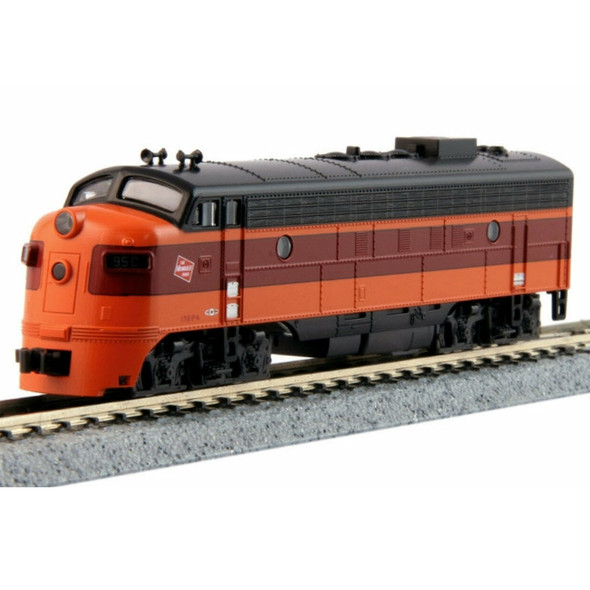Kato
Kato 106-0431-DCC Milwaukee Road FP7A & F7B Set w/TCS DCC #90A & #90B N Scale
- SKU:
- KAT1060431-DCC
- UPC:
- 4949727676579
Frequently bought together:
Description
Kato N Scale EMD FP7A & F7B Set, With TCS DCC (Non-Sound) Milwaukee Road (MILW) #90A & #90B Painted in the Olympian Hiawatha Passenger Livery
Kato Item #: 106-0431-DCC
This new Kato EMD FP7 is matched with an F7B unit. Both are retooled from earlier variations of the F-unit locomotive chassis to make them DCC friendly. Passenger units can be identified by their Steam Generators vs. freight units which lack this detail.
Model Features:
DCC friendly mechanism
With Factory Installed TCS DCC (Non-Sound)
Per-prototype painted in the Milwaukee Road's Orange, Red and Black Scheme representing the post 1952 trainset.
A-unit LED has directional headlight and illuminated number boards
Locomotives have a powerful five pole motor with all wheel electrical pickup and blackened wheels
KATO magnetic knuckle couplers
Prototype History:
The EMD FP7 was a 1,500 horsepower (1,100 kW), B-B dual-service passenger and freight-hauling diesel locomotive produced between June 1949 and December 1953 by General Motors' Electro-Motive Division and General Motors Diesel. Final assembly was at GM-EMD's La Grange, Illinois plant, excepting locomotives destined for Canada, in which case final assembly was at GMD's plant in London, Ontario. The FP7 was essentially EMD's F7A locomotive extended by four feet to give greater water capacity for the steam generator for heating passenger trains. While EMD's E-units were successful passenger engines, their A1A-A1A wheel arrangement made them less useful in mountainous terrain. Several railroads had tried EMD's F3 in passenger service, but there was insufficient water capacity in an A-unit fitted with dynamic brakes. The Atchison, Topeka and Santa Fe Railway's solution was to replace the steam generators in A-units with a water tank, and so only fitted steam generators into the B-units. The Northern Pacific Railway's solution was to fit extra water tanks into the first baggage car, and to pipe the water to the engines. The real breakthrough came when EMD recognized the problem and added the stretched FP7 to its catalog.
View AllClose
Kato Item #: 106-0431-DCC
This new Kato EMD FP7 is matched with an F7B unit. Both are retooled from earlier variations of the F-unit locomotive chassis to make them DCC friendly. Passenger units can be identified by their Steam Generators vs. freight units which lack this detail.
Model Features:
DCC friendly mechanism
With Factory Installed TCS DCC (Non-Sound)
Per-prototype painted in the Milwaukee Road's Orange, Red and Black Scheme representing the post 1952 trainset.
A-unit LED has directional headlight and illuminated number boards
Locomotives have a powerful five pole motor with all wheel electrical pickup and blackened wheels
KATO magnetic knuckle couplers
Prototype History:
The EMD FP7 was a 1,500 horsepower (1,100 kW), B-B dual-service passenger and freight-hauling diesel locomotive produced between June 1949 and December 1953 by General Motors' Electro-Motive Division and General Motors Diesel. Final assembly was at GM-EMD's La Grange, Illinois plant, excepting locomotives destined for Canada, in which case final assembly was at GMD's plant in London, Ontario. The FP7 was essentially EMD's F7A locomotive extended by four feet to give greater water capacity for the steam generator for heating passenger trains. While EMD's E-units were successful passenger engines, their A1A-A1A wheel arrangement made them less useful in mountainous terrain. Several railroads had tried EMD's F3 in passenger service, but there was insufficient water capacity in an A-unit fitted with dynamic brakes. The Atchison, Topeka and Santa Fe Railway's solution was to replace the steam generators in A-units with a water tank, and so only fitted steam generators into the B-units. The Northern Pacific Railway's solution was to fit extra water tanks into the first baggage car, and to pipe the water to the engines. The real breakthrough came when EMD recognized the problem and added the stretched FP7 to its catalog.










